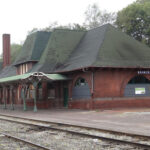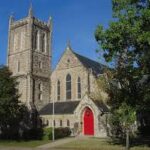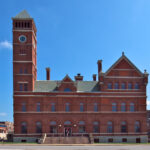National Register of Historic Places
 The National Register of Historic Places is the official list of the nation’s cultural resources worthy of preservation. The program is administered by the National Park Service under the Secretary of the Interior.
The National Register of Historic Places is the official list of the nation’s cultural resources worthy of preservation. The program is administered by the National Park Service under the Secretary of the Interior.
Properties listed on the National Register include districts, sites, structures, and objects that are significant to American history, architecture, archaeology, engineering and culture. These resources contribute to an understanding of the historical and cultural foundations of the nation. The properties, commercial and historic districts are each noted for retaining historic integrity and stand today as excellent examples of architecture or have association to significant events or people.
Keokuk’s National Register of Historic Places
- Keokuk Lock & Dam
Listed October 19, 1978.
Construction on U.S. Lock and Dam #19 began in 1910, and when completed in 1913, it was the largest electricity generating plant in the world. The locks are 1200 feet long and 110 feet wide, with a lift of over 38 feet and large enough to handle a full-length fleet of barges. - George M. Verity River Museum
Listed December 20, 1989.
The George M. Verity River Museum is located in Victory Park on the riverfront. The paddle boat was built in Dubuque, Iowa by the U.S. Government to revive river transportation and move barges from St Louis to St. Paul. It was then known as the S.S. Thorpe. Armco Steel Corporation bought the boat in 1940 and put it into service on the Ohio River, renaming it after the founder of their company, George M. Verity. The George M. Verity was donated to the City of Keokuk in 1961 after being retired from service. - Keokuk Union Depot

117 S. Water St.
Listed March 27, 2013.
The Keokuk Union Depot is locally significant for its contribution to the development of Keokuk and the American railroad system. It is also significant as it represents the work of Burnham and Root Architects. The Keokuk Union depot, built in 1891, was a product of the fast expanding American railroad system when cities were eagerly trying to enhance their railroads to gain maximum transportation and commerce opportunities. In addition, it is one of the last, exceptional Romanesque Revival examples of the illustrious, Chicago architect, John Wellborn Root, before the time of his death. The building conveys simple, borrowed features of the Romanesque Revival movement that was becoming popular within America at that time. - Hotel Iowa
401 Main Street
Listed February 5, 1987.
This eight-story building was built in 1912-1913 to house workers constructing Lock & Dam #19. - Young Women’s Christian Association Building
425 Blondeau Street
Listed October 12, 2004.
This building was designed and constructed specifically to house the activities of the Young Women’s Christian Association (YWCA). For approximately half a century, the building was the home of the Keokuk YWCA. Along with the former YMCA building, which sat directly across the street until it was demolished in 1975, the YWCA building dominated a portion of downtown Keokuk and, with the best facilities for recreational and cultural events, formed the hub of social activity in the community. It is significant locally as the home of a community-supported organization chartered to build character and meet the needs of the women and girls of all ages and backgrounds, and is also one of the best representative examples of transitional architecture prominent during the early part of the 20th century. - Gen. Samuel R. Curtis House
206 High Street
Listed April 23, 1998.
Former home of General Samuel R. Curtis, Iowa’s first major general in the Civil War built this home in the early 1850’s. General Curtis was an engineer, congressman and mayor of Keokuk in 1856. General Curtis was the hero of the Battle of Pea Ridge in Pea Ridge, Arkansas. - St. John’s Episcopal Church

405 Concert Street
Listed July 11, 1989.
Construction on the present building, designed by H. M. Stephenson and Daniel Appleton of Boston, was begun on June 5, 1884. It is one of the most outstanding and best preserved examples of late 19th century ecclesiastical architecture in Keokuk, and the only one that combines Gothic Revival detailing with Richardsonian Romanesque form and massing. It is the oldest Episcopal Church of cruciform construction in Iowa. The present parish hall was added in 1895. Both are built of limestone with a slate roof. An outstanding feature of St. John’s is the more than 40 stained glass windows. - Frank J. Weess House
224-226 Morgan Street
Listed May 22, 1978.
This seventeen room house was constructed from 1880-1881. The architecture represents a rather late expression of the Second Empire style, which reached widespread popularity in Iowa during the 1860s. The property contained a large carriage house and stables and was terraced by a landscape artist. The home originally belonged to Frank J. Wees, a butcher who also had extensive holdings in local real estate. A native of Holland, Weess came to this country in 1849 and by 1860 had established a successful meat business in Keokuk. - Alois and Annie Weber House
802 Orleans Avenue
Listed April 16, 2002.
The Alois and Annie Weber House was built circa 1873 and stands today as an example of the Second Empire architectural style with tall, narrow windows and high ceilings. The Webers were highly respected in Keokuk and throughout the Midwest. Alois Weber opened his own hardware business, A.Weber & Co., and continued its operation until his death in 1917. Annie Weber was also an entrepreneur, establishing and controlling a millinery shop from 1856 until 1887. She died in 1898. - Hugh W. and Sarah Sample House
205 North 2nd Street
Listed November 22, 1995.
Hugh W. Sample, mayor in 1858, had this distinguished brick house built in 1859 and lived in it until his death in 1870. - General William Worth Belknap House
511 North 3rd Street
Listed October 10, 1975.
This is the former home of General William Worth Belknap who brought his mother and two sisters to Keokuk from upstate New York in 1853. Brevet Major-General Belknap participated in many major battles during the Civil War and was later appointed as Secretary of War in Ulysses Grant’s cabinet. In 1857, Belknap was elected to serve in the Iowa Legislature. - Enos H. Harrison House
220 North 4th Street
Listed January 12, 1984.
Built by Enos H. Harrison in 1857 who was a successful businessman from Elizabeth, New Jersey and was instrumental in the establishment of the Iowa State Bank and served as its first president. He was very active in Keokuk’s and Iowa’s early development in areas such as the waterworks, an insurance company, and the Unitarian Church. This Second Empire style house (developed in Paris, France) was probably the first example of a Mansard roof in Iowa. The home’s unique staircase is reported to be one of seven of its type in the country. - Justice Samuel Freeman Miller House
318 North 5th Street
Listed October 10, 1972.
The Miller House Museum, is owned and operated by the Lee County Historical Society. The home was built in 1859 by Samuel F. Miller, a lawyer of national reputation, a physician from Kentucky and who was appointed to the United States Supreme Court by Abraham Lincoln in 1862 where he served for twenty eight years. The Millers lived in the home only two years before departing for Washington. - U.S. Post Office & Courthouse

25 North 7th Street
Listed January 24, 1974.
At 7th and Blondeau Streets, the Lee County Court House and Post Office was built in 1889, an imposing and ornamental structure of brick, stone and terra cotta. Its interior was finished in white oak with cherry and walnut furnishings. The first floor was located the post office and postal departments. The second floor was the federal court room. The third floor were the chambers, private apartment for the judges, jurors’ room and law library. The structure is 108 feet long and 62 feet wide supplied with large plate glass windows and a town clock in the tower. The basement, which is eleven feet high was built of Bedford limestone on the exterior and the interior walls of hard brick. The whole is covered with a slate and copper roof. - John N. & Mary L. Irwin House
633 Grand Avenue
Listed October 14, 1999.
The original builder of this brick residence at the head of North Seventh Street was a pioneer from Pennsylvania, John Daugherty who bought the site from Judge Charles Mason in 1856. John Nichol Irwin, who served five terms as mayor, was territorial governor of Nevada and Arizona and United States minister to Portugal reared his family here. - The Park Place—Grand Avenue Residential District
Listed September 12, 2002.
Keokuk’s successful businessmen built the houses in the Park Place/Grand Avenue residential district over a long period of time and today the neighborhood maintains its status as the “best place to live in Keokuk.” Houses in the district date to 1856, though most were built in the first 30 years of the 20th century, each standing as an excellent example of their architectural style. - Clyde Royal Joy House
816 Grand Avenue
Listed January 16, 1997.
Clyde Royal Joy, associate of the Bakers in the medicine and extract trade built this home in 1897 in the Queen Anne Revival style. Joy was once the controlling stockholder of two businesses and the national director of the Y.M.C.A. This home is now The Grand Anne Bed & Breakfast. - St. Peter Church
301 South 9th Street
Listed July 14, 1983.
In 1879, the foundation was broken, leading the way for excavation of the church which would face Ninth Street. On June 12, 1881, the cornerstone was laid by Fr. B. Spaulding of Peoria. The architectural style of the church is gothic. The stained glass windows, which are hand blown are a main feature of the church. The windows provided by the Mich. Co. of Chicago were made in Munich, Germany. Each of the windows has the same design except for color changes and symbols, with each symbol having a special meaning. The fourteen Stations of the Cross also came from Munich, Germany and were dedicated on February 28, 1892. There are only a few sets like them in America. - Keokuk National Cemetery
Entrances at 18th & Ridge Streets and 1701 J Street
Listed June 4, 1997.
The 2.75-acre Keokuk National Cemetery was originally a part of Oakland Cemetery until the city donated the land to the U.S. government in the mid 19th-century. By the end of the Civil War, the Keokuk National Cemetery had the interments of over 600 Union soldiers and 8 Confederate prisoners of war. The cemetery is currently the final resting place for the remains of over 4,600 American soldiers. The Keokuk National Cemetery is one of America’s earliest national cemeteries.
________________________________________________________________________________________________
Miles Brewer, Keokuk resident and local historian has been a mentor to Dalton Humes in researching and compiling the Keokuk Rifles Trail Guide. This guide tells the history and takes you to some of the more important places on the Keokuk Rifles Trail. The Keokuk Rifles were a local Union Home Defense Unit that fought in the Battle of Athens during the Civil War to re-inforce the Union Soldiers that were in place. To view and download guide, please select here.
